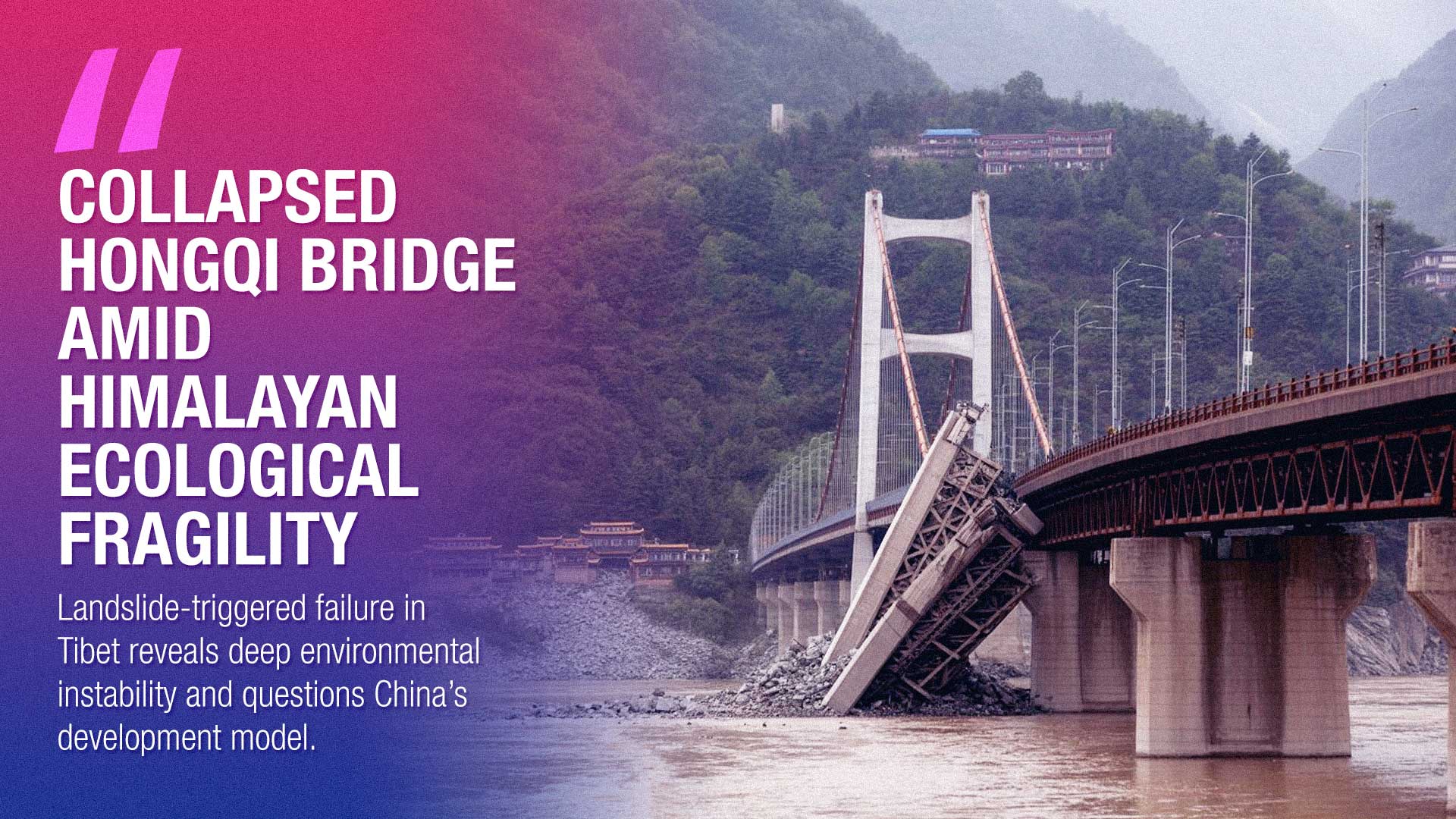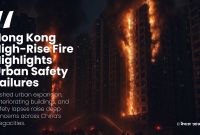China’s Bridge Collapse: An Ecological Warning the World Cannot Afford to Ignore

The collapse of China’s newly built Hongqi Bridge in Tibet after a landslide has drawn global attention to the environmental devastation caused by the faulty policies of the Chinese Communist Party. The collapse of the bridge has come as a big jolt to China’s attempt to project itself as a responsible power leading in clean and green technology after the United States stepped back from climate diplomacy.
Situated in one of Sichuan’s most seismically active zones—where the Tibetan Plateau meets the Sichuan Basin—the Hongqi Bridge was reportedly engineered to withstand earthquakes up to magnitude 8.0. Its cable-stayed design and high-strength materials were meant to overcome the 232-meter drop to the river valley. Yet the collapse highlighted the profound challenges of building in this landscape. Sichuan’s alpine region is notorious for landslides, which have intensified due to climate-change-driven monsoons and the cumulative effects of massive hydroelectric dams upstream, including the Zipingpu Reservoir, which was implicated by several studies in amplifying the 2008 Wenchuan earthquake. Initial investigations pointed to “geological instability” as the primary cause, with no immediate evidence of shoddy workmanship, though inquiries into design and material factors are underway
Designed as a critical artery on National Highway G317, the bridge was intended to strengthen connectivity between China’s dense heartland and the remote Tibetan Plateau—easing the difficult journeys historically undertaken by traders, pilgrims, and local residents navigating the steep, earthquake-prone terrain. That will not happen now.
The bridge, once presented as a symbol of progress and connectivity, has now become a stark reminder of ecological neglect and political recklessness. Tibet’s environment, one of the most delicate and significant on the planet is being reshaped at an alarming rate. The failure of the Hongqi Bridge not only disrupted local transportation but also released vast amounts of debris and pollutants into the surrounding valleys and river systems. The bridge collapse has threatened the already fragile Himalayan ecosystem, which is facing a deepening crisis driven by aggressive resource extraction and unrestrained infrastructure expansion. It has shaken the confidence of the people of Tibet who have long lived under the shadow of environmental vulnerability and state-imposed development pressures.
This has further endangered the fragile Himalayan ecosystem, already reeling from decades of resource extraction and infrastructure expansion.
Experts have long accused the Chinese leadership of a relentless pursuit of political control and economic gain in Tibet. Under the banner of modernization, China has launched sweeping construction projects across the region, including illegal and hazardous hydropower dams along major rivers such as the YarlungTsangpo. These projects—frequently undertaken without proper environmental assessments or local consultation—threaten to destabilize the river systems that sustain nearly two billion people across Asia. They increase the risk of landslides, flooding, and seismic disturbances in what is already one of the world’s most unstable geological zones.
These environmental disasters deeply impact local communities, who are often forced to relocate, lose their livelihoods, and confront the erosion of cultural identity.
The architectural dimensions of the collapse also warrant attention. Experts argue that the question in mountain engineering is not how to overpower nature but how to design in partnership with it. The Hongqi Bridge was originally conceived as an attempt to integrate human infrastructure with the terrain, treating the mountains not as obstacles but as essential elements of design. Its architectural vision aimed to turn risk into elegance—transforming steep slopes into graceful movement and making mountainous structures among the most innovative engineering achievements.
The key lesson from the collapse is not merely a failure of engineering but the urgent need for an architectural philosophy that anticipates dynamic environmental forces from the outset.The landslide revealed the limitations of conventional monitoring systems and underscored the importance of smart sensing technologies embedded directly into structural frameworks—capable of recognizing subtle ground shifts long before catastrophic failure occurs.
The Hongqi Bridge collapse casts a harsh light on a governance model that prioritizes political optics over ecological integrity and control over compassion. Without meaningful international scrutiny and accountability, Tibet’s natural environment—and the millions of lives dependent on its rivers and ecosystems—will continue to face grave, human-made dangers.
The disaster has also revived global concerns about Chinese-built infrastructure abroad. Although China downplayed the accident by emphasizing the absence of casualties, the incident has heightened international suspicion regarding construction materials sourced from China. In the United States, experts raised significant safety concerns about the new Bay Bridge connecting San Francisco and Oakland, which used Chinese steel and labour. California had rejected federal funding because it required American steel, opting instead for Chinese manufacturers with no previous bridge-building experience. Expert testimony later revealed that the steel was too brittle; bolts and rods cracked, all 750 panels required repairs, and long rods suffered failures linked to hydrogen embrittlement in the grade BD steel.
The Hongqi Bridge collapse is a warning signal for countries across the globe, with far-reaching implications. As the incident went viral worldwide, countries, including the United States, must press China to explain the real reasons behind the failure instead of just relying on vague and politically curated statements.
The ecological disruptions in Tibet and the Himalayan region have consequences that go far beyond China’s borders. Any imbalance in this fragile ecosystem—home to the sources of Asia’s major rivers—can trigger devastating impacts on biodiversity, water security, and regional stability.
It is time for global powers, environmental bodies, and affected nations to demand transparency, independent investigations, and accountability from Beijing. If China continues unchecked in its pattern of risky construction and ecological negligence, the world must consider appropriate diplomatic, environmental, and legal actions. Protecting the Himalayas is not just a regional necessity—it is a responsibility of the entire world.
China’s Bridge Collapse




![From Kathmandu to the World: How Excel Students Are Winning Big [Admission Open]](https://nepalaaja.com/img/70194/medium/excel-college-info-eng-nep-2342.jpg)
